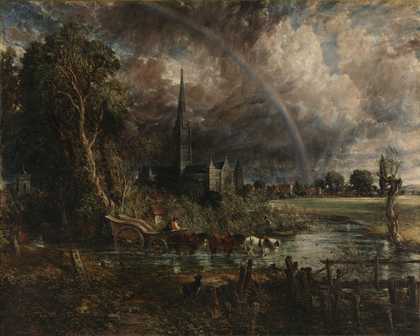
Fig.1
John Constable
Salisbury Cathedral from the Meadows exhibited 1831
Tate
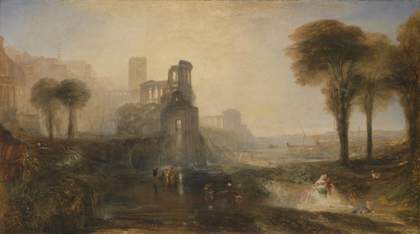
Fig.2
J.M.W. Turner
Caligula’s Palace and Bridge exhibited 1831
Tate
Following its acquisition by Tate in 2013, John Constable’s Salisbury Cathedral from the Meadows (fig.1) toured nationally under the auspices of the Aspire partnership, created to celebrate the picture and share it with a wide audience in the context of other UK public collections.1 Each partner venue created its own display. Having returned to Tate Britain, the picture was hung in the Clore Gallery with J.M.W. Turner’s Caligula’s Palace and Bridge (fig.2), in a partial reconstruction of their appearance together at the Royal Academy in 1831 when they were hung side by side.2 Constable was on the Academy’s hanging committee (formally, the Committee of Arrangement) that year and was responsible for the final layout of the pictures, opting to hang his own work between Caligula’s Palace and another painting by Turner, The Vision of Medea 1828, in prime positions in Somerset House’s Great Room. At first, the committee had placed Caligula’s Palace centrally on the wall but Constable moved it to one side and replaced it with his own picture without warning Turner, who was understandably upset; Constable stood accused of favouring his own picture. Concentrating on Salisbury Cathedral and Caligula’s Palace and paying less attention to Medea (consequently not shown in Tate’s display in the Clore Gallery), critics compared the artists’ distinctive achievements and characters. Articulating opinions formed over previous decades, they laid foundations for future understandings of these preeminent landscape painters. Extracts from press reviews were shown at Tate during the Aspire display and more are discussed in this paper. But what did the 1831 exhibition mean for the painters themselves? If a contest as well as a competition, how evenly was it balanced? And how friendly? Was it really, in the words of art historian Ian Warrell, ‘a key battle in a longer war’?3 How did the artists’ careers, relationships and critical receptions, and the politics and culture of display as they had evolved so far, bring them to this point in 1831? What part did the shift of emphasis from landscape to subject painting on the part of a younger generation of artists, very evident by 1831, play in shaping their work and the expectations of critics?
Reputations: the artists, the academy and the critics
Constable’s attitude to the Royal Academy was uncomfortable if not ambivalent. Very early, he decided there was nothing in its annual exhibitions worth looking up to.4 Years later he called it a ‘pandemonium’ of bad pictures vomited by the devil.5 Yet he knew it was indispensable as the place to learn, make a reputation, find a market and measure himself against his peers. When he first exhibited there in 1802, he told his friend John Dunthorne ‘It shows me where I am, and in fact tells me what nobody else could’.6 This was not always what he wanted to hear. That he had to wait until 1819 to be elected an Associate of the Academy and another ten years to be promoted to Academician, this time by only one vote, shows how halting his progress had been compared to Turner’s rapid ascent. Just a year younger than Turner, Constable was a late starter, entering the Academy Schools in 1799 and first exhibiting in 1802. It was also this year that Turner, who had begun his studies a decade earlier, was elected an Academician. Turner first served on the Academy Council and the hanging committee in 1803 and held other senior posts in the years afterwards, including Professor of Perspective.7 The gulf between their achievements as young men would have been hard to bridge even if Constable had not struggled for recognition while Turner, however controversial, never lost the aura of a prodigy. After a few early upsets, Turner became an insider for whom the Academy provided status and a surrogate family. Constable often seemed an outsider trying to break in or admitted on sufferance.
While Constable did little to discourage this impression, reinforcing it to his future biographer C.R. Leslie, it can be misleading.8 Family money allowed Constable a degree of independence that left him open to accusations of dilettantism or even amateurism. While Turner had to work hard to make connections, Constable found himself with a ready supply of relations and neighbours who introduced him to influential figures like the collector Sir George Beaumont, or hosted dinners to present him to senior artists.9 Almost all of Constable’s early exhibits were hung in the Academy’s coveted Great Room, suggesting some favourable influence at work on his behalf. Critics ignored them, but neither were they always complimentary about Turner’s contributions. Both artists came in for criticism of their characters and conduct. In 1814 the Examiner, usually known for its warm reviews, published an anonymous complaint that Turner had demeaned the Academy by entering a competition at the rival British Institution intended for emerging artists.10 Turner responded by bemoaning the
system of detraction by comparison and personality … that any man’s reputation should be immolated to enhance the value of a penny sheet of paper to 8 pence ½ is no cheering prospect. And the public to relish it (even as a joke upon Joe) [is] deplorable indeed.11
Prescient of today’s tabloids, this could equally apply to slurs later directed at Constable. At first, comparisons with an artist as prominent as Turner worked to Constable’s advantage, raising his profile while differentiating his work, albeit often in simplistic or stereotypical terms. Later, when critics turned against them both, sometimes for similar reasons, they brought them closer. Constable probably owed Turner more than he knew, but rather enjoyed pretending to be snubbed if it showed up Turner’s bad manners. Visiting Turner to canvass his support in an election for Academician in 1828, he was amused to find Turner (who disliked being interrupted while working) ‘angry that I called on a Monday afternoon’.12 When finally elected in 1829, perhaps by Turner’s deciding vote after his first choice Charles Eastlake dropped out, Constable was pleased that ‘though last not least’ Turner and his friend the artist George Jones called to congratulate him.13 In 1818, Turner had chaired the Artists General Benevolent Institution when Constable was elected a Director, a charitable role that helped offset his sometimes awkward reputation.
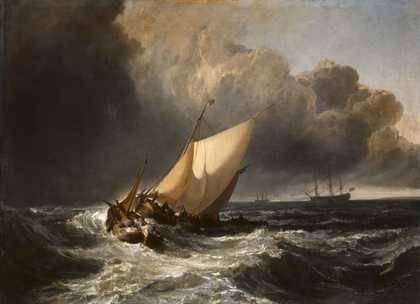
Fig.3
J.M.W. Turner
Dutch Boats in a Gale (‘The Bridgewater Sea Piece’) 1801
Private collection, on loan to the National Gallery, London
That Constable eventually saw Turner as his only real rival was held against him as arrogance. Was this rivalry hostile? Even at their most competitive, early in 1832, Constable could write of dining with Turner and Jones ‘snugly – alone’.14 Neither from their correspondence – Constable’s admittedly franker and more extensive – nor from mutual friends including Leslie and Turner’s future executor Henry Scott Trimmer is there much evidence for the claim by Turner’s unreliable biographer Walter Thornbury that Turner ‘did not much like Constable’ who ‘in secret, was most severe on Turner’s pictures’.15 What is clear and unsurprising is that Constable had his eye on Turner long before Turner noticed him. They were first seen at the same time, but not together, in 1799, at the London house of William Beckford, viewing pictures by Claude Lorrain recently brought from Rome. Constable’s first known comment on Turner’s work dates from 1801, when he admired Turner’s Dutch Boats in a Gale 1801 (fig.3) but said he knew the picture by Dutch artist Willem van de Velde on which it was based. Beaumont, who had mixed feelings about Dutch Boats, probably influenced Constable’s qualified praise, the tone he maintained after Beaumont turned hostile the following year with robust attacks on Turner’s latest pictures including Calais Pier 1803 (National Gallery, London).16 Constable’s opinion of Turner’s watercolours of Salisbury Cathedral which he saw at their owner’s Wiltshire seat Stourhead in 1811 is not known, but he could hardly have missed them – he was there with the Bishop of Salisbury and their host Richard Colt Hoare, for whom they were painted, thought they were the ‘acme of perfection’.17 When it was first exhibited in 1812, Constable found Snow Storm, Hannibal and his Army crossing the Alps ‘scarcely intelligible in many parts’ but altogether ‘novel and affecting’.18 In 1814 he preferred his own ‘ploughing scene’ A Summerland (private collection) to Turner’s Dido and Aeneas, admired by many other artists but of which ‘my own opinion was decided the instant I saw it’.19 Yet Dort, or Dordrecht. The Dort Packet-Boat from Rotterdam becalmed (Yale Center for British Art, New Haven, Connecticut) exhibited at the Academy in 1818 impressed him enough to be remembered in 1832 – with ‘most of Turner’s early pictures’ – as ‘one of singular intricacy and beauty … a canal with numerous boats, making thousands of beautiful shapes … the most complete work of genius I ever saw’.20
How much had Turner observed Constable during the same period? Neither seems to have noticed that the other was exhibiting a picture of the Battle of Trafalgar in 1806. Constable’s watercolour His Majesty’s ship ‘Victory’, Capt. E. Harvey, in the memorable battle of Trafalgar, between two French ships of the line (Victoria and Albert Museum, London) hung at the Academy, while Turner’s large oil The Battle of Trafalgar, as Seen from the Mizen Starboard Shrouds of the Victory was on show in his own gallery in Harley Street. While we might expect the English pastoral and river subjects Turner showed in Harley Street from 1805 to be more to Constable’s taste than the grander compositions he usually sent to the Academy, Constable’s first documented visit to Turner’s Gallery took place, with their fellow artist Joseph Farington, on 24 May 1813. Turner was out and his father greeted them instead. Presumably, Constable was preparing for a dinner at the Academy four days later, when he was seated next to Turner (opposite Academy President Benjamin West and the portrait painter Thomas Lawrence). This was his first attendance at such an event, partly thanks to Turner, who had recently voted to admit exhibitors who were not yet members. Constable wrote to his future wife Maria Bicknell that he ‘was a good deal entertained with Turner … he is uncouth but has a wonderfull [sic] range of mind’.21 To rouse Constable’s competitive spirit, his friend John Fisher told him Turner’s Frosty Morning was ‘a picture of pictures’ in the Academy and the only one he preferred to Constable’s Landscape: Boys Fishing (Anglesey Abbey), adding ‘you are a great man like Bounaparte [sic], and are only beaten by a frost’.22 Odd as Napoleon’s disastrous retreat from Moscow might seem to rally a struggling painter, friends like Fisher had been Constable’s only source of encouragement in the absence of press reviews. 1813 marked a turning point, not just for Constable but, as Robert Hunt wrote in the Examiner, for ‘Landscape, in which there is much advancement among the rising Artists’.23
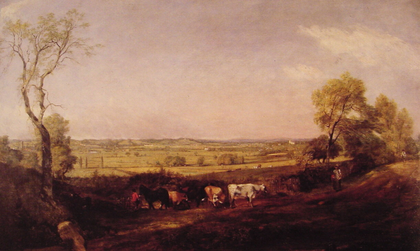
Fig.4
John Constable
Dedham Vale: Morning 1811
Collection of William Proby
Hunt, a notably sensitive and articulate critic, was reviewing the British Institution’s exhibition where Constable exhibited Dedham Vale: Morning 1811 (fig.4), previously shown at the Academy in 1811. At Somerset House this picture had caused Constable ‘much uneasiness of mind’ by being hung ‘very low’ in the Ante Room, ‘proof’, he thought, that he had ‘fallen in the opinion of the members’.24 Was this reversal revenge for his sometimes caustic comments about fellow artists? Or, since most of his earlier pictures in the Great Room had generic titles implying imaginative distance from the locations depicted, did the site-specific Dedham Vale seem more topographical, and so somehow less inspired? For its exhibition at the British Institution in 1813, Constable renamed it ‘Landscape’, adding only that it was ‘a scene in Suffolk’. Meanwhile in the Academy, Landscape: Boys Fishing was hung in the Inner Room or School of Painting on the second floor, also not a prime location, but according to West was admired by the whole Academy Council. Of Constable’s ‘six foot’ river landscapes shown between 1819 and 1825, three with generic titles were hung in the Inner Room and two with specific ones in the Great Room, suggesting nomenclature was not a factor in deciding where pictures were placed.25 However, reviewers did observe conceptual differences, if not between Constable’s own pictures then from those by other artists. As well as the rise of landscape, Hunt’s critique of the 1813 Academy praises ‘great improvements’ in Constable’s ‘silvery, sparkling’ colour, ‘true to the greyish-green colouring of most of our English summer landscapes’.26 But, Hunt suggests, these improvements have only taken him so far – Constable is still an emerging artist, limited to what Hunt would describe in 1817 as his ‘close portraiture of our English scenery’.27 That this is not entirely a compliment can be inferred from Hunt’s previous praise of Turner’s Dido and Aeneas as ‘that rare species of Landscape, which is addressed more directly to the imagination rather than the memory, and which places it in the same class of intellect with Poetry’.28
Poetry and portraiture
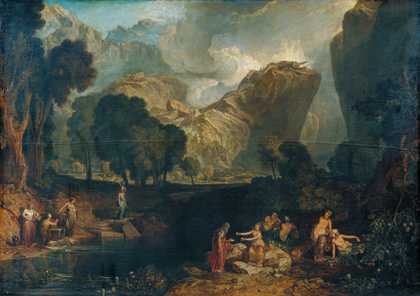
Fig.5
J.M.W. Turner
The Goddess of Discord Choosing the Apple of Contention in the Garden of the Hesperides exhibited 1806
Tate
Praising Turner’s poetic imagination was not new, and certainly not for Hunt, whose brother Leigh Hunt was himself a poet. The Hunts’ friend the engraver John Landseer (father of the artist Edwin Landseer) had ended a long review of the exhibition at Turner’s Gallery in 1808 with a passage on The Goddess of Discord Choosing the Apple of Contention in the Garden of the Hesperides exhibited 1806 (fig.5):
The imagination of the artist, whether painter or poet, when thus raised or – in the language of poets – exalted by the Muse, looks down upon Nature and the nether world, revolves its creative energies, and accomplishes its lofty purposes with a power of volition which conquerors might envy and angels might admire.29
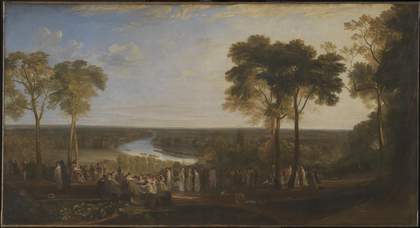
Fig.6
J.M.W. Turner
England: Richmond Hill on the Prince Regent’s Birthday exhibited 1819
Tate
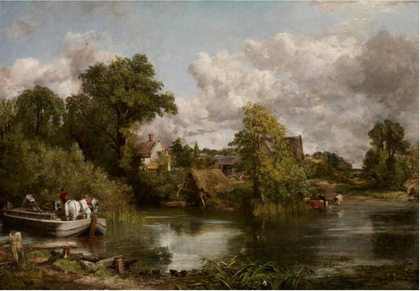
Fig.7
John Constable
The White Horse 1819
The Frick Collection, New York
What was different was placing it in a hierarchy of landscape in which Constable’s realism was distinct, if not implicitly ranked lower. Hunt enlarged on his point, comparing the exhibition at the 1819 Academy of Turner’s England: Richmond Hill on the Prince Regent’s Birthday (fig.6) and Constable’s The White Horse (fig.7), then called ‘Scene on the River Stour’. While he deemed the works ‘equally successful’, he outlined what he saw as their principal difference:
[Constable] does not give a sentiment, a soul to the exterior of Nature, as Mr Turner does; he does not at all exalt the spectator’s mind, which Mr Turner eminently does, but he gives her an outward look, her complexion and physical countenance, with more exactness. He has none of the poetry of Nature like Mr Turner, but he has more of her portraiture.30
Whether reflecting or leading opinion, this remained the consensus for some time, even among Constable’s admirers.
The White Horse was the first of Constable’s ‘six foot’ Stour river scenes. Based on full-size sketches which he then elaborated, partly to address the issues of finishing – or lack of it – that had troubled his critics, these aimed at near-heroic depictions of what the Champion, sounding bored by their repetition, called ‘Water-Mills, Water-Locks, Navigable Canals, and a Flat Cultivated Country’.31 English as these were, definitively so in Constable’s eyes, and modern at the time, critics tended to compare them with Dutch Old Masters. Doubtless this was frustrating for Constable when the modern pictures he was competing with on his own distinctive territory were more obviously based on luminous riverscapes by the Dutch artist Aelbert Cuyp (1620–1691). Turner’s Dort, shown the previous year, and similarly-sized river and canal scenes exhibited annually by A.W. Callcott, beginning in 1816 with The Entrance to the Pool of London (Trustees of the Bowood Settlement), were patently Cuyp-esque works, capitalising on the British enthusiasm for the artist recently sealed by the Prince Regent’s purchase of Cuyp’s celebrated Passage Boat c.1650 (Royal Collection) from Sir Francis Baring in 1814. Positioning – spatial and social – was critical to the success of these large pictures. They looked best hung on the line in the Great Room, allowing colleagues and exhibition visitors to step back to grasp their effect.32 Callcott, who was on the hanging committee in 1817, moved his Mouth of the Tyne (private collection) to make way for Turner’s Dort at the centre of a wall. This generous gesture may not have entirely made up for previously giving his own picture pride of place, an unusual misstep for this most suavely diplomatic of painters. Constable’s White Horse hung in the Inner Room in 1819. While there were complaints that it was ‘so near the eye’, the opportunity to examine it closely may have helped convince enough members to at last admit him as an Associate.33 Turner’s friend the painter Thomas Phillips thought it was his best work yet but was still sceptical and advised Constable to study the landscape prints in Turner’s Liber Studiorum to learn how to ‘make a whole of his pictures’.34 Constable, who had staked so much on a larger canvas and sometimes joked about the ‘liber stupidorum’, was unimpressed.35 He was also apprehensive about the election, having heard that Callcott would never vote for him and that attendance at the ballot was likely to be low. Turner, away in Italy, was a significant absentee. Nevertheless, on 1 November Constable was elected by eight votes at the second ballot.
If Constable felt overshadowed by Turner this year, even from a distance, it would be understandable – the exceptional size of Turner’s England: Richmond Hill, its depiction of a famous view on the nation’s premier river and deference to the Prince Regent had made a blatant pitch for the Academy’s prime spot, or indeed royal patronage as Charles Stuckey and others have argued.36 Yet Constable sold his White Horse – to his friend John Fisher who would later be the moving spirit behind Salisbury Cathedral from the Meadows – and Turner found no buyer for England: Richmond Hill. Perhaps Turner’s attention-seeking backfired if we believe an illustration by Thomas Rowlandson to Dr Syntax’s tour of the ‘pleasures and miseries of London life’, showing his picture hanging unflatteringly low and best seen sitting down. It was also this year that colleagues objected to Turner’s activities during the Varnishing Days, the final days before the exhibition opened to the public. They complained about the impact of his ‘flaming colour’ on neighbouring pictures and ‘pernicious effects arising from Painters working upon their pictures in the Exhibition’.37 However, Turner’s other exhibit in 1819, Entrance of the Meuse: Orange-Merchant on the Bar, Going to Pieces; Brill Church bearing S.E. by S., Masensluys E. by S., was hailed for its ‘unrivalled powers of imitation from nature’ and ‘noblest powers of landscape painting’.38 These merits, and the personal associations Turner wove into England: Richmond Hill – the likely date of his birthday, 23 April, being the same as the Prince Regent’s name day; his out-of-town retreat at Twickenham falling within its background – might show Turner drawing closer to Constable’s realm of pictorial ‘affections’.39 It has also been suggested that Constable’s father-in-law, who among other legal roles was the Regent’s solicitor, proposed he paint The Opening of Waterloo Bridge (‘Whitehall Stairs, June 18th, 1817’) (fig.18) eventually exhibited in 1832 and hence discussed later in this paper, as a rival for royal favour.40 By now the two artists were increasingly mentioned together. In 1820, when Constable’s Stratford Mill (National Gallery, London) hung in the Great Room to mark his election as Associate, Hunt compared Constable to ‘boasted foreigners of former days’ and ‘great continental Artists’, and placed him with Turner and Callcott among the moderns ‘in nerve of thought, feeling, judgment, and invention’.41 One of Hunt’s articles may have been the ‘highly panegyrising’ notice that Constable showed Farington that June.42
Turner’s interest in the Old Masters, extending to portrayal and pastiche, put his hitherto inexorable rise on hold if not into reverse in 1820. Constable’s English naturalism was easier for the press to articulate than the mingled art historical and autobiographical directions taken by Turner in his sole Academy exhibit in 1820, Rome, from the Vatican. Raffaelle, Accompanied by la Fornarina, Preparing his Pictures for the Decoration of the Loggia. Recently back from Italy, Turner identified himself with the Renaissance painter Raphael (1483–1520) and the Baroque sculptor and architect Gian Lorenzo Bernini (1598–1680) whose later arcades in St Peter’s Square also feature, anachronistically, in the picture. Although The British Press admired the ‘sentiment and grandeur’ of these ‘architectural ruins’, critics were puzzled by the combination.43 After not showing at all in 1821, Turner returned to the Academy in 1822 with What You Will! (Clark Art Institute, Williamstown, Massachusetts), a small, playful fantasy in the manner of the French painter Jean-Antoine Watteau (1684–1521) and perhaps a riposte to his detractors. ‘Mr Turner has nothing of Art this season’, protested the Examiner, answering the picture’s implied question with ‘“Almost anything but what a picture ought to be”’.44 Effectively, Turner had left the field clear for Constable whose main exhibit in the 1821 Academy, hung in the Inner Room, was ‘Landscape – Noon’, now known as The Hay Wain (National Gallery, London). For Hunt, it ‘approaches nearer to the actual look of rural nature than any modern landscape’.45 View on the Stour near Dedham (Huntington Library, San Marino), Constable’s six-foot exhibit in 1822, attracted similar praise.
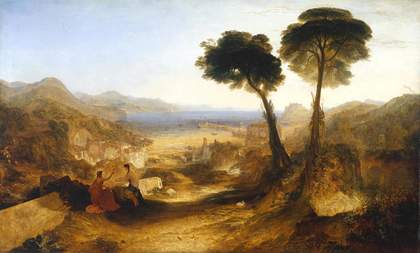
Fig.8
J.M.W. Turner
The Bay of Baiae, with Apollo and the Sibyl exhibited 1823
Tate
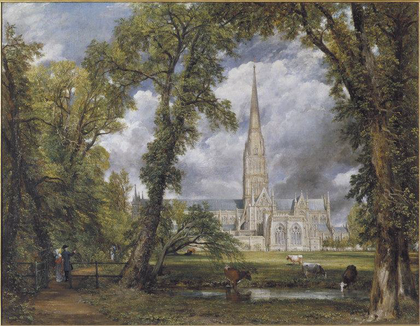
Fig.9
John Constable
Salisbury Cathedral from the Bishop’s Grounds exhibited 1823
Victoria and Albert Museum, London
1823 saw Turner back on spectacular form in another lone Academy picture, The Bay of Baiae, with Apollo and the Sibyl (fig.8). Inspired by Ovid’s Metamorphoses and the classical landscapes of Claude Lorrain, this idyll of beauty and decay contrasted with Constable’s main contribution, Salisbury Cathedral from the Bishop’s Grounds (fig.9), renewing debates about poetic idealism and naturalism in painting. Critics went into raptures about Turner’s picture despite the obvious exaggerations that prompted his friend Jones to write ‘SPLENDIDE MENDAX’ (gorgeous lie) on its frame.46 For the Literary Gazette it was ‘the vision of a poet … embodied by a painter’ while Constable’s work was ‘striking but mannered’.47 Admiring ‘the peculiarities of Mr. Constable’s style’, the European Magazine (having presumably seen Jones’s graffiti) was ‘annoyed by the cold-blooded critic … who observed that [Turner’s picture] was not natural. Natural! No, not in his limited and purblind view of nature. But perfectly natural to the man who is capable of appreciating … all that nature occasionally and partially discloses of the rich, the glowing and the splendid’.48 The Monthly Magazine came to a different conclusion:
[Turner’s] fine poetical scene is so outrageous in colour as even to eclipse all his former extravagancies. These visionary absurdities are upon a par with much of the music and poetry of the day: affectation and refinement run mad. Constable’s fresh and powerful transcripts from nature are convincing proofs of her superiority to the sophistications of art.49
Constable’s opinion was succinct: ‘Turner is stark mad – with ability’.50
Gold and silver

Fig.10
J.M.W. Turner
Harbour of Dieppe (Changement de Domicile) 1825
The Frick Collection, New York
Constable was far from immune to poetry. He did not write it, as Turner did, but like Turner he read it and quoted it with his pictures – perhaps borrowing the habit from Turner himself. Irritated by some particularly fatuous French reviews describing The Hay Wain and View on the Stour in the Paris Salon in 1824 as ‘warblings of the Aeolian lyre, which mean nothing’, Constable retorted, ‘Is not some of this blame the highest praise – what is poetry? – What is Coleridge‘s Ancient Mariner (the very best modern poem) but something like this?’.51 Just as galling must have been British critics going to the other extreme, simultaneously describing his naturalism as portraiture and Turner’s fervid imagination as poetic. Yet by the mid-1820s it seemed Turner was overdoing the poetry. Colour (especially yellows as bright as the latest pigments would allow) was the fault-line that set him apart. Dazzled by the brilliance of Harbour of Dieppe (Changement de Domicile) (fig.10) at the Academy in 1825, the diarist Henry Crabb Robinson thought ‘No one could find fault with a Garden of Armida, or even of Eden, so painted. But we know Dieppe, in the north of France, and can’t easily clothe it in such fairy hues. I can understand why such artists as Constable and [William] Collins are preferred’.52
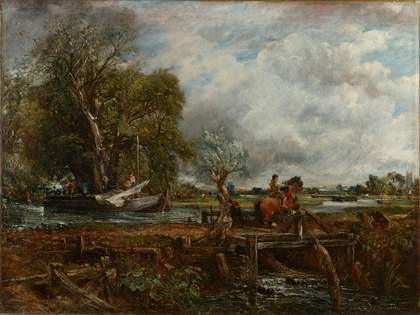
Fig.11
John Constable
The Leaping Horse 1825
Royal Academy of Arts, London
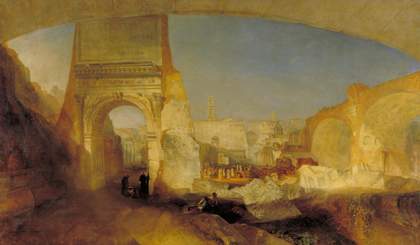
Fig.12
J.M.W. Turner
Forum Romanum, for Mr Soane’s Museum exhibited 1826
Tate
The cool English colouring of Constable’s The Leaping Horse 1825 (fig.11) in the same exhibition was the antithesis of the ripe glow suffusing Turner’s picture. Robert Hunt, in his Examiner review, praised both the ‘superb Sea-port by Turner [and] Nature’s own Landscapes by Constable’.53 Taking stock of his current standing, Constable wrote: ‘I feel deeply the honour of having found an original style & independent of him who would be Lord over all – I mean Turner’.54 Save for a few reviews, Constable had triumphed in Paris in 1824; winning a gold medal at the Salon along with Thomas Lawrence in an exhibition where Turner was not included had boosted his confidence. He accepted that Turner had the edge for his ever-expanding subject-matter, adding ‘it would be difficult to say that there is a bit of landscape that does not emanate from that source’.55 Yet Turner’s yellow phase allowed Constable’s subtler effects to shine. In 1826, the Literary Gazette thought Turner had ‘sworn fidelity to the Yellow Dwarf‘;56 the New Monthly Magazine claimed that his Forum Romanum, for Mr Soane’s Museum (fig.12) and Cologne, the Arrival of a Packet-Boat (Frick Collection, New York) looked as if they had been copied from models made of amber.57 Soane did not take possession of Turner’s Forum, buying a similarly-sized but soberly-toned Italian lake scene by Callcott instead.58 In Constable’s eyes this year, ‘Turner never gave me so much pleasure – and so much pain before’, but added, ‘every man who distinguishes himself in a great way, is on a precipice’.59
Well aware what some critics were saying, Turner sent Robert Balmanno, another critic, a cutting of a typical review:
It is impossible there can be a greater contrast of colour than is found between Mr Constable and Mr Turner [where] all is yellow, yellow, nothing but yellow … With greater invention in his works than any master of the present day – invention which amounts almost to poetry in landscape, Mr Turner has degenerated into such a detestable manner, that we cannot view his works without pain … [We] wish Mr Turner to turn back to Nature, and worship her as the goddess of his idolatry.60
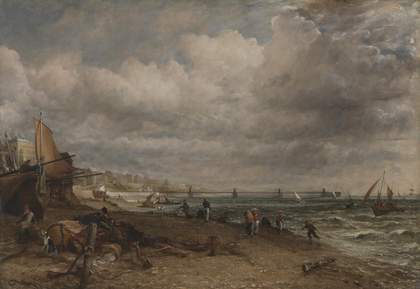
Fig.13
John Constable
Chain Pier, Brighton 1826–7
Tate
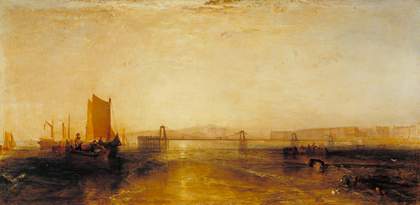
Fig.14
J.M.W. Turner
Brighton from the Sea c.1829
Tate
In other words, he should become like Constable whose Cornfield (National Gallery, London) was also exhibited this year. For the Examiner, Hunt wrote a lyrical description of its ‘sapphire sky and silver clouds, its emerald trees and golden grain, its glittering reflexes of sunlight’; as well as a moving tribute to Constable, whom he described as
not so potent a genius [as Turner]; but in the rural walk … one of the most natural Painters of his time. He pays his addresses to Nature in his native country, Britain … He has been faithful to his first love … from the commencement of his career. He is a chaste Painter, and goes hand in hand with her alone.61
In 1827, Hunt paid similar attention to the use of colour in Constable’s Chain Pier, Brighton (fig.13) – ‘less mannerist than most others … tenderly mellowed, the natural look of English atmosphere, half-sullen and half-smiling’.62 Fisher worried that as marine painters thinking Constable was encroaching on their territory, ‘Turner, Calcott [sic] and Collins will not like it’.63 In fact, this most Turnerian of Constable’s pictures recalls the Turner of twenty years earlier when he and Callcott were known as ‘white painters’ rather than his gaudier recent incarnation.64 Constable could not have known that Turner, unpredictable as ever, would show more muted pictures this year including the silvery Port Ruysdael (Yale Center for British Art, New Haven) which ‘retrieved his character’.65 If there was rivalry here, it seems to have continued. Around two years later, Turner painted a different view of the pier, in his most golden palette, for Lord Egremont (fig.14). Egremont had invested in the pier’s construction and had a house in Brighton, so perhaps he was the ‘man of rank’ who asked the price of Constable’s picture but did not buy it.66
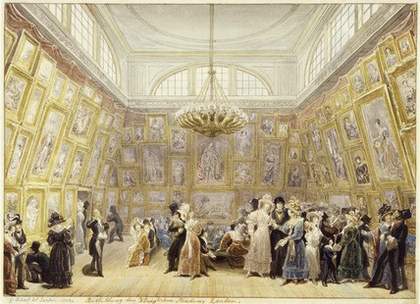
Fig.15
George Scharf
Exhibition at the Royal Academy, London 1828
Museum of London
In 1828, Constable showed his unsold Chain Pier again at the British Institution. In the Academy he had nothing to compare with Turner who, he wrote, ‘has some golden visions – glorious and beautiful, but they are only visions – yet still they are art – and one could live with such pictures in the house’.67 The largest, Dido Directing the Equipment of the Fleet was the picture of the year, hanging at the head of the Great Room below a portrait of the Duke of Sussex. On the hanging committee that year for the first time since 1803, Turner must have been party to this flattering arrangement, recorded in a watercolour of the exhibition by George Scharf (fig.15). Now a wreck, the canvas gives no sign of the ‘astonishingly bold’ dark pine tree, ‘brilliant and glowing verdure’ or ‘unpleasant buff’ reflections that exercised critics – ‘perhaps Dido liked it; now we don’t’ – along with its mastery of architectural perspective in the reconstruction of ancient Carthage.68
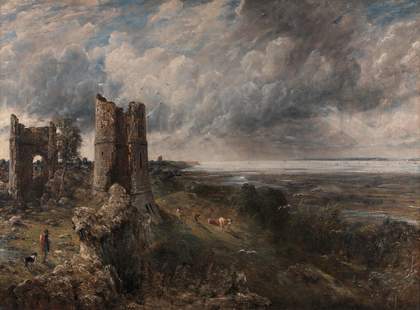
Fig.16
John Constable
Hadleigh Castle: The Mouth of the Thames, Morning after a Stormy Night 1829
Yale Center for British Art, New Haven

Fig.17
J.M.W. Turner
Ulysses Deriding Polyphemus 1829
National Gallery, London
We can still compare, as critics did in the Academy in 1829, Constable’s Hadleigh Castle: The Mouth of the Thames, Morning after a Stormy Night (fig.16) hung in the Inner Room, and Turner’s Ulysses Deriding Polyphemus (fig.17), which hung in the Great Room. English landscape and antiquity versus classical blockbuster, cool beside hot, these juxtapositions had been previously rehearsed in the pictures of Baiae and Salisbury in 1823 and would be repeated in 1831. Reviewing ‘our best Academicians’, the London Magazine named Turner as ‘romantic … in the poet’s spirit’, and Constable ‘vigorous’, before comparing them: ‘Mr. Constable’s works present no stronger contrast … than they do with Mr. Turner’s …The first is all truth, the last all poetry: the one is silver, the other gold’.69 Years later the same distinction between ‘the most opposite modern painters’ was repeated by Leslie, without the original sting in the tail: for the 1829 reviewer, Constable’s silver had been ‘manner’, Turner’s gold ‘style’, and ‘We shall never derive perfect satisfaction from Mr. Constable’s works, until his silvery effect be abandoned’.70 Rather than overall tonality, this refers to the scattered white highlights increasingly present in Constable’s pictures – ‘that accursed bespotting with blanc d’argent, or white-wash splashing, as Mr. Turner will have it’.71 The Athenaeum quoted another version of this description (‘splashing from a white-washing ceiling’) which, if not apocryphal, is Turner’s only known comment on Constable’s art.72
The ‘manner’ so described was widely criticised, as was the rough surface texture of Constable’s pictures. The artists themselves joined in, Constable retorting that he had heard one of Turner’s pictures compared to a hospital ‘spitting box’.73 No doubt this sparring was good-humoured. Less so were press comments soured by the professional jealousies and rivalries into which, as a new Academician, Constable was inevitably drawn. In 1829 the lawyer-critic Edward Dubois, who supplied malice and muckraking to the Morning Chronicle and Observer, could find only lazy praise for Constable and Turner while smearing artists like Constable who ‘sneak in’ to favour through connections or wealth. Constable’s wife had recently inherited some money to add to his own private means and in 1830 Dubois accused him of buying his election, claiming ‘he has certainly not improved in art as he has in fortune, to which latter he entirely owes the obsequiousness of the Academy, and the long struggled-for R.A.’.74 This was tendentious speculation but Dubois was not alone in thinking Constable’s work ‘coarse’. On the hanging committee for the first time this year, Constable watched it reject his Water Meadows near Salisbury (Victoria and Albert Museum, London) as a ‘nasty green thing’ – as Academicians were entitled to show eight pictures automatically, it must have become mixed up with works by non-members.75 Possibly it was not recognised as his work as it was so unlike his current practice. Despite this setback, rumours spread that Constable was giving himself and his friends preferential positions.
Constable took Dubois’s attacks personally, telling Fisher how his ‘duty as “Hangman”, has not been the most enviable – it may account for some of the scurrilities in the newspapers … Still … I have acted conscientiously and my mind is at rest’.76 It had been a thankless task to arrange ‘a melancholy display, of the selfishness of our profession’ with only ‘half silly’ James Ward to help.77 While Constable’s main exhibit Helmingham Dell (Nelson-Atkins Museum of Art, Kansas City) was hung in the Great Room, a particular difficulty this year was how to place Turner, who had sent not only highly characteristic coast scenes but also Pilate Washing his Hands, with its extremes of light and shadow, and Jessica. Both were bound to provoke the critics and the latter in particular was showered with unprecedented abuse – not least by Dubois. The Morning Chronicle proposed that in future the Academy Council should have power to veto aberrations like Pilate and ‘that thing called Jessica’.78
1831: The Hangman Hammered
Constable was a ‘Hangman’ for the last time in 1831. The exhibition that year was significant for several reasons. It brought Constable and Turner into direct competition as never before, thanks to Constable himself. It showed younger artists like Eastlake and William Etty gaining ground alongside established ones. It also gave a German painter, Johann David Passavant, a basis for the ‘tolerably complete survey’ of modern British art that he added to his account of the nation’s Old Master collections, later translated by Elizabeth Rigby, the future Lady Eastlake, as Tour of a German Artist in England (1836).79 Passavant admires individual pictures but not the exhibition. Eastlake is described as a ‘pearl’ surrounded by ‘tinsel’;80 Etty is grand but ‘eccentric’ and ‘licentious’;81 Callcott’s ‘commendable severity’ provides ‘unalloyed gratification’.82 Turner is ‘decidedly’ the most talented landscape painter but damaged by ‘extravagance of effect, and total neglect of form’.83 ‘Speaking of extravagant artists’, adds Passavant, ‘we may include John Constable’.84 In Passavant’s view, the exhibition corrodes its contributors, its rivalrous spectacle making them aggressively competitive and creating a cult of individualism and attention-seeking. Turner thrived in these conditions. His jousts with friends and rivals during Varnishing Days became legendary but rarely caused resentment. Constable was less adept or practised at these art-world games and this year he overplayed his hand at Turner’s expense. In 1832, writing to Leslie about the ‘horrors of our annual show’, he admitted he deserved to be punished, having ‘played the devil with others’.85
Constable showed two pictures in 1831, principally the six-foot Salisbury Cathedral from the Meadows. Turner outnumbered him again, with six new pictures including Caligula’s Palace and Bridge and The Vision of Medea, previously painted and exhibited in Rome. Selecting these large canvases to hang with Salisbury Cathedral in the Great Room, the hanging committee began by placing Caligula’s Palace as the centrepiece, flanked by Salisbury Cathedral and Vision of Medea. At a late stage, Constable moved his own picture to the centre – without telling Turner. He was under no obligation to do so as the hanging committee was supposed to keep its decisions secret but in practice this was impossible and there was a long history of exhibitors upset to find their work moved or demoted. Now it was Turner’s turn to be displeased and Constable’s to be put on the spot. For Turner’s friend David Roberts, the affair revealed his colleagues’ personalities: Turner always ‘modest of his own abilities’, Constable ‘talking of himself and his works, and unceasing in his abuse of others’.86 At the same dinner table with Roberts and Turner shortly afterwards, Constable was ‘lavish of the pains he had taken and the sacrifices he had made [and] Turner was down on him like a sledge-hammer; it was no use his endeavour to persuade Turner that the change was to his advantage, and not his own. Turner kept at it all the evening, to the great amusement of the party’.87 There is another version of Roberts’s story, even harder on Constable:
[Turner] opened upon [Constable] like a ferret; it was evident to all present Turner detested him … Constable wriggled, twisted & made it appear or wished to make it appear that in his removal of the Picture he was only studying the best light or the best arraignment for Turner. The latter coming back invariable to the charge, yess [sic], but why put your own there … Constable looked to me and I believe to everyone else, like a detected criminal, and I must add Turner slew him without remorse.88
While Roberts, who was already partisan, sounds as if he is settling some personal scores and Turner over-acting to entertain the party, can we take Constable at his word? Had he separated Turner’s very different – and differently sized – pictures so they did not knock each other out? Placing photographs of the three pictures in the original order suggests that this could have been the case. From Turner’s perspective, however, Constable’s swap removed him from pole position in the exhibition and compared unfavourably with Callcott’s opposite manoeuvre in 1818, when he moved his own picture to make way for his friend’s Dort.
The Morning Post described the final arrangement:
Three pictures … among the most remarkable in the Exhibition … are hung together at the upper end of the large room, occupying nearly three-fourths of its entire width. Nos.162 [Caligula’s Palace] and 178 [Vision of Medea] are the offspring of Mr. Turner’s fertile and vivid imagination; No.169 [Salisbury Cathedral], which stands immediately between the other two, is from the palette of Mr. Constable: and three productions more strongly bespeaking the hand of genius, betraying more glaring defects, or fraught with more redeeming beauties, will not easily be found.89
Passing quickly over Vision of Medea, which most of them disliked, critics concentrated on Caligula’s Palace and Salisbury Cathedral, often to the former’s advantage. The Athenaeum praised Turner’s ‘poetry of nature’ and La Belle Assemblée his ‘fancy and genius … poesy itself’;90 Dubois likened Salisbury Cathedral to ‘”Old Towler” roared out by a coal-heaver’.91 In an extended comparison he also attacked Constable’s ‘coarse, vulgar imitation of Mr. Turner’s freaks and follies – a mimicry of his extravaganzas, to attract notice, without any of their poetical feeling and clear indication of a masterly genius … Grievous is it to see in the latter so much Charlatanerie – in the former it is contemptible’.92 Other writers were more even-handed. The Englishman’s Magazine praised ‘Turner’s fire and Constable’s rain’.93 The Literary Gazette likewise placed them on an equal level:
Fire and water. If Mr. Turner and Mr. Constable were professors of geology … the first would certainly be a Plutonist, the second a Neptunist. Exaggerated, however, as both these works are, – the one all heat, the other all humidity, – who will deny that they both exhibit, each in its own way, some of the highest qualities of Art? None but the envious and ignorant.94
Missing from these critiques – which focus on the familiar technical ‘faults’, especially in Constable’s case – is any sense of style as an agent of meaning. There is almost no discussion of the subjects of these pictures. At a time when younger artists were moving away from landscape to narrative, it might be expected that landscapes should be about something. Hardly noticed is their status as architectural landscapes of ancient Italy and medieval and modern England, nor their displays of perspective and knowledge of the Old Masters: Claude Lorrain’s Landscape with Psyche and the Palace of Amor 1664 (National Gallery, London) for Turner; Jacob van Ruisdael’s Jewish Cemetery c.1650s (Detroit Institute of Arts) and Peter Paul Rubens’s An Autumn Landscape with a View of Het Steen in the Early Morning c.1636 (National Gallery, London) and Rainbow Landscape 1636 (Wallace Collection, London) for Constable. Comments on Turner’s poetry ignore the verses he actually wrote for his picture, here discussed below. The Gentleman’s Magazine notices that Constable ‘professes to have embodied on canvas a scene from [James] Thomson’s Summer’ only to complain that it appears to depict a snow storm.95 Least of all do critics ask themselves if these pictures have anything to say a year after the French Revolution of 1830 – one that overturned the restored Bourbon monarchy and established the ‘Citizen king’ Louis-Philippe, an old acquaintance of Turner’s, on the throne; or the same year as Greece broke free from the Ottoman Empire. It was also this year that the House of Lords rejected a reading of the Reform Act, delaying the extension of the vote to unrepresented groups and the reduction of ecclesiastical privileges.96 These events encapsulated the liberal and reactionary sentiments of the time, respectively represented by Turner and Constable.
Whether the turbulence and transience expressed by Constable is personal, political or both has been much discussed since but was not at the time when, if reviewers were unaware of the recent loss of Constable’s wife, they must surely have known that the Anglican Church felt threatened by political change. Today we know that Constable’s anguish over Reform passed as quickly as a summer storm, that he regarded Fisher’s fears for his church as a ‘Phantom’ and was sceptical of pictorial symbolism.97 Commenting in an 1835 lecture on Ruisdael’s Jewish Cemetery, which he knew as ‘Allegory of the Life of Man’, he judged it ‘failed, because he attempted to tell that which is outside the reach of art’.98 Quoting Thomson’s lines on light after storm in the Academy catalogue when he exhibited his Salisbury Cathedral, the bereaved painter invited a poetic interpretation for the picture, but perhaps not to make private grief public, omitted what may hold the key to its deepest meaning for him.99
In Thomson’s preceding lines, Amelia is killed by lightning, leaving Celadon in despair, and the poet asks, ‘But who can paint the lover, as he stood/Pierced by severe amazement, hating life/Speechless, and fix’d in all the death of woe!’100 Here may be the question that Constable asks himself, and answers in the picture – he can. But to deny that it also raises questions about the political and religious condition of the nation – as happened as recently as 1991 – seems perverse.101
Turner’s epigraph for Caligula’s Palace, ascribed to his manuscript poem ‘Fallacies of Hope’, also asks a question; what remains of his great bridge across the Bay of Baiae save ‘fragments left/As monuments of doubt and ruined hopes’?102 Again, the picture provides the answer; like the extravagant palace, it is now a ghost outlived by Italy’s natural beauty. Turner traced this sentiment to its source in Childe Harold’s Pilgrimage – Italy exhibited 1832, named after Lord Byron’s epic poem Childe Harold’s Pilgrimage. Previously, the bridge had exposed the hubris of Caligula’s dreams of power. Built to refute a prophecy that Caligula could no more become emperor than drive his chariot across the bay, the bridge came to symbolise his vanity and extravagance. Turner owned Oliver Goldsmith’s Roman History (1771), which castigated Caligula’s excesses and Edward Gibbon’s Decline and Fall of the Roman Empire (1776), where the emperor appears as a lunatic claiming divinity while unleashing an age of decline that brought the former Republic to its knees and turned Romans into slaves.103 Dictatorship by a crazed imperial oligarchy can hardly be compared to the British state awaiting reform in 1831. Yet Turner, unlike Constable, was prone to using history to reflect on the present and of their pictures that year, his may have had more to offer to the Reform movement, arising from the progressive side of the debate. Perhaps, reading around his subject, he came across Gibbon’s account of how, after Caligula was murdered, the senate convened under the watchword ‘liberty’ and briefly reclaimed its former freedoms. Its rebellion collapsed, just as Reform was held up by the Lords in 1831. Whether or not Turner intended his subject to resonate in modern times, neither his Roman ruins nor Constable’s ‘church under a cloud’ prompted any mention of Reform in the press. Instead one of Turner’s smaller pictures in the exhibition, Lucy, Countess of Carlisle, and Dorothy Percy’s Visit to their Father Lord Percy, when under Attainder upon the Supposition of his being concerned in the Gunpowder Plot, put Dubois in mind of ‘the present Percy, Duke of Northumberland … with the stomach-ache [and] the daughters of corruption announcing to him the success of Reform’.104
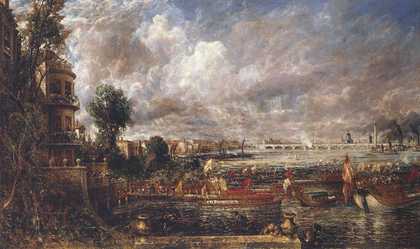
Fig.18
John Constable
The Opening of Waterloo Bridge (‘Whitehall Stairs, June 18th, 1817’) exhibited 1832
Tate
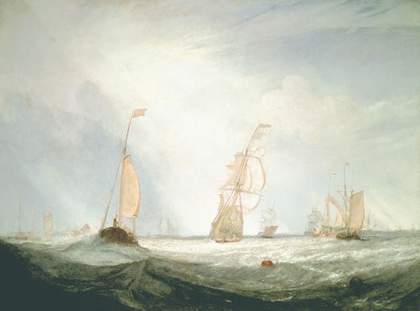
Fig.19
J.M.W. Turner
Helvoetsluys exhibited 1832
Fuji Art Museum, Tokyo
While their critical histories prior to 1831 help to account for the reception of Turner and Constable’s pictures that year, they expose the limitations of critical discourse at the time, which still tended to revert to the ‘fulsome and ignorant panegyric, and rancorous and undistinguishing abuse‘ lamented by the Morning Post in 1794.105 It would be unreasonable to expect short-fire journalism to produce analysis to compare with the rigour and breadth that Constable brought to his lectures on the history of landscape painting or Turner reached in the more lucid passages in his Academy Perspective Lectures.106 Nor does either painter seem to have commented on the other’s picture when alongside his own. One more such comparison followed in 1832, when Constable’s Opening of Waterloo Bridge (‘Whitehall Stairs, June 18th, 1817’) (fig.18) and Turner’s much smaller Helvoetsluys (fig.19) hung alongside one another in the Academy’s Inner Room. This was a less equal pairing, as the pictures were so different in size, but became more memorable for provoking one of Turner’s public interventions during the Varnishing Days and a rare response from Constable. Faced with the brilliant reds in Constable’s picture, Turner added a blob of red, which he eventually turned into a buoy, to his own greyish sea, prompting Constable to protest he ‘has been here, and fired a gun’.107 If Turner for once felt outshone by Constable, and took his revenge, Dubois thought ‘Mr.C appears to think that he is a Turner, and that because … Turner has indulged in his vagaries and absurdities, he may do the same; but there is an excellent fable of the patient quadruped & the lap-dog … that the antics of one may have admirers, which will be something worse than ridiculous in the clumsy imitation of the other’.108 As in the better-known fable of the tortoise and the hare, Constable had now caught up with Turner, but only to share the same frivolous mockery with his rival. The reunion of Salisbury Cathedral and Caligula’s Palace at Tate Britain in 2018, and of Opening of Waterloo Bridge and Helvoetsluys running concurrently at the Royal Academy from January 2019 were opportunities to see again some of the primary materials on which contemporary critiques were based, and to test first impressions against the longer view available to us today.109
First exhibitions and reactions were after all only the beginning of the story. Constable was already thinking of his legacy when he began Salisbury Cathedral in 1829, buying back his earlier view from the Bishop’s grounds and The White Horse from Fisher that year. 1831 not only saw the new picture exhibited but the publication of English Landscape Scenery, his retrospective of his own art in mezzotints by David Lucas. The same engraver began a large-scale print of Salisbury Cathedral in 1835, which was eventually published in 1848. Constable reworked the picture before showing it again in the British Institution in 1833, Birmingham in 1834 and Worcester in 1836.110 According to Leslie he believed it would become recognised as his masterpiece, the fullest expression of his art. But in his Executors’ sale in 1838 friends including Leslie passed it over in favour of The Cornfield 1826 (National Gallery, London) to represent him in the National Gallery because they thought the latter more likely to appeal to the public. Constable had opposed the creation of a ‘national gallery’ for fear it would promote the ‘manufacture’ of pictures – art imitating art at the expense of study from nature. John Ruskin, whose poor opinion of Constable was disproportionately based on Lucas’s prints, could never bring himself to allow Constable much credit for setting an example of painterly naturalism. Turner (albeit selectively) was Ruskin’s natural painter. Apart from appearances in the great Art Treasures exhibition in Manchester in 1857 and at London’s Grosvenor Gallery in 1888, Salisbury Cathedral was not seen again in public until shown at the Royal Academy in 1934, beginning a modern rehabilitation that still has not convinced all Constable’s admirers. Turner’s Caligula’s Palace also became the subject of a large print, engraved by Edward Goodall in 1842. It came to the National Gallery with the Turner Bequest in 1856 but fell into the category of classical fantasies dismissed by Ruskin as ‘nonsense pictures’.111 While there and later at the Tate Gallery, the work was not chosen for any exhibition until Turner’s bicentenary at the Academy in 1974–5.112 In 1983 Constable’s Salisbury Cathedral was lent to the National Gallery by Lord Ashton of Hyde, whose ancestor Samuel Ashton had bought it in 1857. For three decades, it hung with Constable’s Hay Wain, Stratford Mill and Cenotaph to the Memory of Sir Joshua Reynolds 1833–6 in the same room as Turner’s Dutch Boats, Calais Pier, and Ulysses Deriding Polyphemus as well as The Fighting Temeraire exhibited 1839, which Constable did not live to see. Here, among other icons of the British School, the display of these works rebalanced the reputations of the ‘most opposite modern painters’ in ways that would surely have astonished them both.
